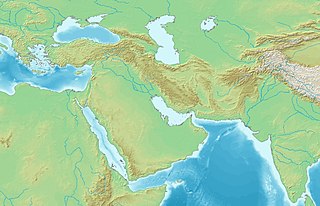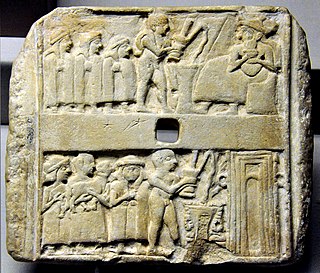
Enlil, later known as Elil, is an ancient Mesopotamian god associated with wind, air, earth, and storms. He is first attested as the chief deity of the Sumerian pantheon, but he was later worshipped by the Akkadians, Babylonians, Assyrians, and Hurrians. Enlil's primary center of worship was the Ekur temple in the city of Nippur, which was believed to have been built by Enlil himself and was regarded as the "mooring-rope" of heaven and earth. He is also sometimes referred to in Sumerian texts as Nunamnir. According to one Sumerian hymn, Enlil himself was so holy that not even the other gods could look upon him. Enlil rose to prominence during the twenty-fourth century BC with the rise of Nippur. His cult fell into decline after Nippur was sacked by the Elamites in 1230 BC and he was eventually supplanted as the chief god of the Mesopotamian pantheon by the Babylonian national god Marduk. The Babylonian god Bel was a syncretic deity of Enlil, Marduk, and the shepherd deity Dumuzid.

Atra-Hasis [Atra-ḫasīs] is an Akkadian epic, recorded in various versions on clay tablets, named for its protagonist, Atrahasis. The Atra-Hasis tablets include both a creation myth and one of three surviving Babylonian flood myths. The name "Atra-Hasis" also appears, as king of Shuruppak in the times before a flood, on one of the Sumerian King Lists.

In Sumerian religion, Ninlil, also called Sud, in Assyrian called Mulliltu, is the consort goddess of Enlil. Her parentage is variously described. Most commonly she is called the daughter of Nunbarsegunu and Haia. Another Akkadian source says she is the daughter of Antu and Anu. Other sources call her a daughter of Anu and his mother, Nammu.

The Lament for Ur, or Lamentation over the city of Ur is a Sumerian lament composed around the time of the fall of Ur to the Elamites and the end of the city's third dynasty.

The Dynasty of Isin refers to the final ruling dynasty listed on the Sumerian King List (SKL). The list of the Kings Isin with the length of their reigns, also appears on a cuneiform document listing the kings of Ur and Isin, the List of Reigns of Kings of Ur and Isin.

Sumerian religion was the religion practiced and adhered to by the people of Sumer, the first literate civilization of ancient Mesopotamia. The Sumerians regarded their divinities as responsible for all matters pertaining to the natural and social orders.
George Aaron Barton was a Canadian author, Episcopal clergyman, and professor of Semitic languages and the history of religion.

The Barton Cylinder is a Sumerian creation myth, written on a clay cylinder in the mid to late 3rd millennium BCE, which is now in the University of Pennsylvania Museum of Archaeology and Anthropology. Joan Goodnick Westenholz suggests it dates to around 2400 BC.

The Gudea cylinders are a pair of terracotta cylinders dating to circa 2125 BC, on which is written in cuneiform a Sumerian myth called the Building of Ningirsu's temple. The cylinders were made by Gudea, the ruler of Lagash, and were found in 1877 during excavations at Telloh, Iraq and are now displayed in the Louvre in Paris, France. They are the largest cuneiform cylinders yet discovered and contain the longest known text written in the Sumerian language.

The "Debate between sheep and grain" or "Myth of cattle and grain" is a Sumerian creation myth, written on clay tablets in the mid to late 3rd millennium BCE.

The Debate between Winter and Summer or Myth of Emesh and Enten is a Sumerian creation myth, written on clay tablets in the mid to late 3rd millennium BC.

Enlil and Ninlil or the Myth of Enlil and Ninlil or Enlil and Ninlil: The begetting of Nanna is a Sumerian creation myth, written on clay tablets in the mid to late 3rd millennium BC.

Self-praise of Shulgi is a Sumerian myth, written on clay tablets dated to between 2100 and 2000 BC.

The Kesh Temple Hymn or Liturgy to Nintud or Liturgy to Nintud on the creation of man and woman is a Sumerian tablet, written on clay tablets as early as 2600 BCE. Along with the Instructions of Shuruppak, it is the oldest surviving literature in the world.

Ekur, also known as Duranki, is a Sumerian term meaning "mountain house". It is the assembly of the gods in the Garden of the gods, parallel in Greek mythology to Mount Olympus and was the most revered and sacred building of ancient Sumer.

The Hymn to Enlil, Enlil and the Ekur , Hymn to the Ekur, Hymn and incantation to Enlil, Hymn to Enlil the all beneficent or Excerpt from an exorcism is a Sumerian myth, written on clay tablets in the late third millennium BC.

Miscellaneous Babylonian Inscriptions is a 1918, Sumerian linguistics and mythology book written by George Aaron Barton.

The Song of the hoe or the Creation of the pickax is a Sumerian creation myth, written on clay tablets from the last century of the 3rd millennium BCE.

The concept of a Garden of the gods or a divine paradise may have originated in Sumer. The concept of this home of the immortals was later handed down to the Babylonians who conquered Sumer.
Kudur-Enlil, rendered in cuneiform as Ku-durdEN.LÍL, “son of Enlil,” was the 26th king of the 3rd or Kassite dynasty of Babylon. He reigned into his ninth year, as attested in contemporary economic tablets. His relationship with his predecessor and successor is uncertain and does not appear in contemporary inscriptions. The personal name “Marduk is king of the gods” first appears during his reign marking the deity’s ascendancy to the head of the pantheon.














